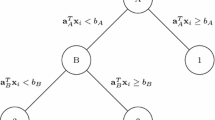Abstract
Finding the best phylogenetic tree under the maximum parsimony optimality criterion is computationally difficult. We quantify the occurrence of such optima for well-behaved sets of data. When nearest neighbor interchange operations are used, multiple local optima can occur even for “perfect” sequence data, which results in hill-climbing searches that never reach a global optimum. In contrast, we show that when neighbors are defined via the subtree prune and regraft metric, there is a single local optimum for perfect sequence data, and thus, every such search finds a global optimum quickly. We further characterize conditions for which sequences simulated under the Cavender–Farris–Neyman and Jukes–Cantor models of evolution yield well-behaved search spaces.






Similar content being viewed by others
References
Allen BL, Steel M (2001) Subtree transfer operations and their induced metrics on evolutionary trees. Ann Comb 5(1):1–15
Atteson K (1999) The performance of the neighbor-joining methods of phylogenetic reconstruction. Algorithmica 25:251–278
Bastert O, Rockmore D, Stadler PF, Tinhofer G (2002) Landscapes on spaces of trees. Appl Math Comput 131(2–3):439–459
Bordewich M, Gascuel O, Huber KT, Moulton V (2009) Consistency of topological moves based on the balanced minimum evolution principle of phylogenetic inference. IEEE/ACM Trans Comput Biol Bioinform (TCBB) 6(1):110–117
Caceres AJJ, Castillo J, Jinnie J, St John K (2013) Walks on SPR neighborhoods. IEEE/ACM Trans Comput Biol Bioinform 10(1):236–239
Cartwright RA (2005) DNA assembly with gaps (Dawg): simulating sequence evolution. Bioinformatics 21(Suppl 3):iii31–iii38
Cavender JA (1978) Taxonomy with confidence. Math Biosci 40(3):271–280
Charleston MA (1995) Toward a characterization of landscapes of combinatorial optimization problems, with special attention to the phylogeny problem. J Comput Biol 2(3):439–450
Chen S, Montgomery J, Bolufé-Röhler A, Gonzalez-Fernandez Y (2015) Invited paper: a review of thresheld convergence. GECONTEC Revista Internacional de Gestión del Conocimiento y la Tecnología 3(1):1–13
Cormen TH, Leiserson CE, Rivest RL, Stein C (2001) Introduction to algorithms, 2nd edn. MIT Press, Cambridge
Dress A, Krüger M (1987) Parsimonious phylogenetic trees in metric spaces and simulated annealing. Adv Appl Math 8(1):8–37
Farach M, Kannan S (1999) Efficient algorithms for inverting evolution. JACM 46(4):437–449
Farris JS (1970) A method for computing wagner trees. Syst Zool 19:83–92
Farris JS (1973) A probability model for inferring evolutionary trees. Syst Biol 22(3):250–256
Fitch WM (1971) Towards defining the course of evolution: minimum change for a specific tree topology. Syst Zool 20(4):406–416
Fitch WM, Margoliash E et al (1967) Construction of phylogenetic trees. Science 155(760):279–284
Foulds LR, Graham RL (1982) The Steiner problem in phylogeny is NP-complete. Adv Appl Math 3(1):43–49
Garnier J, Kallel L (2001) Efficiency of local search with multiple local optima. SIAM J Discrete Math 15(1):122–141
Goloboff PA, Farris JS, Nixon KC (2008) TNT, a free program for phylogenetic analysis. Cladistics 24(5):774–786
Hein J (1990) Reconstructing evolution of sequences subject to recombination using parsimony. Math Biosci 98(2):185–200
Hendy MD, Foulds LR, Penny D (1980) Proving phylogenetic trees minimal with l-clustering and set partitioning. Math Biosci 51(1):71–88
Hendy MD, Penny D (1982) Branch and bound algorithms to determine minimal evolutionary trees. Math Biosci 59(2):277–290
Hillis DM, Mable BK, Moritz C (1996) Molecular systematics. Sinauer Associates, Sunderland
Jukes TH, Cantor CR, Munro HN (1969) Mammalian protein metabolism. Evol Protein Mol 3:21–132
Kirkup B, Kim J (2003) From rolling hills to jagged mountains: scaling of heuristic searches for phylogenetic estimation. Mol Biol Evol (in revision)
Li M, Tromp J, Zhang L (1996) Some notes on the nearest neighbour interchange distance. In: COCOON ’96: proceedings of the second annual international conference on computing and combinatorics. Springer, London, pp 343–351
Maddison DR (1991) The discovery and importance of multiple islands of most-parsimonious trees. Syst Zool 40(3):315–328
Money D, Whelan S (2012) Characterizing the phylogenetic tree-search problem. Syst Biol 61(2):228–239
Moulton V, Steel M (1999) Retractions of finite distance functions onto tree metrics. Discrete Appl Math 91(1):215–233
Neyman J (1971) Molecular studies of evolution: a source of novel statistical problems. In: Gupta SS, Yackeleds J (eds) Statistical decision theory and related topics. Academic Press, New York, pp 1–27
Nixon KC (1999) The parsimony ratchet, a new method for rapid parsimony analysis. Cladistics 15(4):407–414
Robinson DF (1971) Comparison of labeled trees with valency three. J Comb Theory Ser B 11(2):105–119
Rokas A, Williams BL, King N, Carroll SB (2003) Genome-scale approaches to resolving incongruence in molecular phylogenies. Nature 425:798–804
Saitou N, Nei M (1987) The neighbor-joining method: a new method for reconstructing phylogenetic trees. Mol Biol Evol 4:406–425
Semple C, Steel M (2003) Phylogenetics. Oxford lecture series in mathematics and its applications, vol 24. Oxford University Press, Oxford
Stamatakis A, Blagojevic F, Antonopoulos CD, Nikolopoulos DS (2007) Exploring new search algorithms and hardware for phylogenetics: RAxML meets the IBM cell. J VLSI Signal Process Syst 48(3):271–286
Steel MA (1994) The maximum likelihood point for a phylogenetic tree is not unique. Syst Biol 43(4):560–564
Swofford DL (2002) PAUP*. Phylogenetic analysis using parsimony (*and other methods). Version 4. Sinauer Associates, Sunderland
Varón A, Vinh LS, Wheeler WC (2010) POY version 4: phylogenetic analysis using dynamic homologies. Cladistics 26(1):72–85
Wheeler WC (2012) Systematics: a course of lectures. Wiley-Blackwell, New York
Acknowledgments
The authors would like to thank Mike Charleston, Kevaughn Gordon, Barbara Holland, and Ward Wheeler for insightful and helpful discussion and the anonymous referees and Associate Editor Mike Steel for their comments which greatly improved this paper. We would also like to thank the American Museum of Natural History for hosting the first author as a visiting summer student. Partial funding was provided by the US National Science Foundation (#0920920 to KS) and the Simons Foundation.
Author information
Authors and Affiliations
Corresponding author
Rights and permissions
About this article
Cite this article
Urheim, E., Ford, E. & St. John, K. Characterizing Local Optima for Maximum Parsimony. Bull Math Biol 78, 1058–1075 (2016). https://doi.org/10.1007/s11538-016-0174-0
Received:
Accepted:
Published:
Issue Date:
DOI: https://doi.org/10.1007/s11538-016-0174-0




